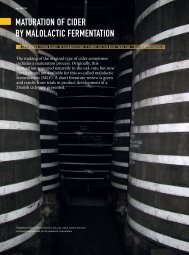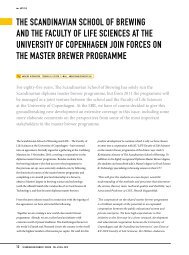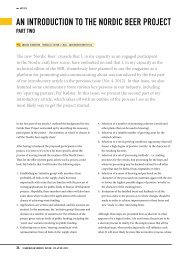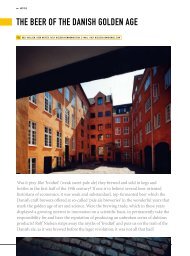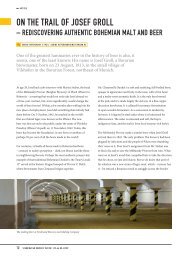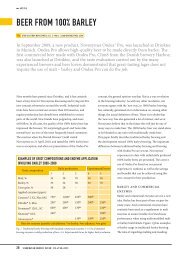BreWiNG OF eNGliSH StYle aleS WitH MalteD ... - Scandbrewrev.dk
BreWiNG OF eNGliSH StYle aleS WitH MalteD ... - Scandbrewrev.dk
BreWiNG OF eNGliSH StYle aleS WitH MalteD ... - Scandbrewrev.dk
Create successful ePaper yourself
Turn your PDF publications into a flip-book with our unique Google optimized e-Paper software.
B R E W I N G O F E N G L I S H S T Y L E A L E S W I T H M A L T E D C E R E A L S …in bottle, using malted cereals other than barley in the gristcompositions. Alternative cereals are, of course, used verysuccessfully as adjuncts in many beers. Indeed, several beerbrands use rice and maize as grits, but cereal cookers arerequired; very few U.K. brewing operations have cereal cookingfacilities. Further, unmalted sorghum and barley itself can besatisfactorily used, but usually require substantial additions ofenzymes (of fungal and/or bacterial origin) during mashing,with protracted mashing programmes, involving severalgraduated temperature changes. There are numerous instancesin which other cereals have been used in unmalted forms inspecialist applications, for example as flours or as pre-gelatinisedflaked products in a number of beers, such as, Oatmeal Stouts.Wheat flour (also in compressed pellet form) has been appliedto enhance head retention in several beer types.However, using unmalted cereals as grist adjuncts can presentcertain challenges, such as milling problems (especially withwet or steep-conditioning mills) and undesirable flavours mayarise from the ‘cooking’ conditions occurring during the flakingprocess.By using malted cereals, you avoid many of the potentiallynegative features and allow higher grist proportions to be usedwithout the need to consider the use of additional mashingenzymes. In addition, there is a certain element of provenanceassociated with malted cereals, which can be especiallyimportant in marketing considerations for beers such astraditional English cask ales.For these reasons, we have brewed with malted oats, maltedwheat and malted rye as part of our Seasonal Beers strategy(‘Four Seasons Ales’). There has been a close associationbetween Ushers and Simpson’s Malt for many years and anumber of pilot-scale brewing trials have previously beencarried out, using a range of malted cereal varieties producedby Simpson’s Malt. As a consequence of this collaboration, awide range of speciality malts are now commercially available.SELECTION CRITERIAThe selection of the cereals to be used in the range of beers tobe produced on a seasonal basis was more related to marketingstrategy than any considerations of seasonal availability orharvesting. Consequently, wheat was chosen for the summerbeer because of the established tradition of producing light,refreshing beers brewed with wheat in the summer. Rye has aclassical autumnal connotation, whereas oats have an obvious,albeit frivolous, association with springtime. More importantly,it had already been established through the joint pilot studiesthat Simpson’s could readily produce malts from these cerealsand had identified suitable varieties that were readily available,as follows:Oats - the winter variety – ‘Imagen’ (also selected because ofits larger grain size),Wheat - the winter variety – ‘Riband’ (a soft wheat, knownto malt satisfactorily for brewing, as well as used for breadmaking),Rye - the winter variety – ‘Halo’MALTING CHARACTERISTICSAn indication of the main compositional features of thesecereals in comparison with malting barley (U.K. 2-row) ispresented in Table l. The importance of these features on thecharacteristics of the malts produced is detailed below.Table 1 - Average Compositions (% by weight)Barley Oats Wheat RyeSoluble Carbohydrate 78 70 79 80Protein 12 11.5 14 13.5Lipid 2 5 2.5 2Fibre 5 10.5 2.5 2Mineral 3 3 2 2.5OatsThe relatively low carbohydrate content is reflected in low potentialextract and the high fibre content is a consequence of thehigh husk fraction (and small endosperm). The total nitrogenlevel is similar to barley (U.K. 2-row), but it is found that onlysome 10% remains permanently soluble. Further, oats have ahigh lipid content. The grain size is slightly longer than barley,but considerably narrower (approx. 1/2 the diameter).WheatWheat has a loose husk which is not retained during maltingand leads to rapid moisture uptake. The protein contents tendto be significantly higher than barley and, as a rule, modificationand friability are poorer with lower levels of free amino-nitrogen,although enzyme levels (especially amylolytic activities)tend to be higher with enhanced extracts. The grain size isapproximately the same as barley, but rounder.HALTING PROCEDURESSome of the key features employed in the malting proceduresare detailed below.SCANDINAVIAN BREWERS’ REVIEW . VOL.65 NO.1 2008 19



